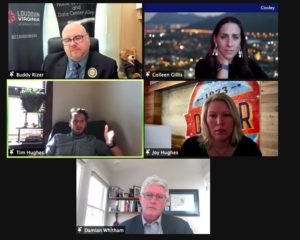Top Story
Leadership Insights from Paola Moya
Even before starting Moya Design Partners, I wanted to ensure that my designs and projects reflected my personal mission, supporting...
January 4, 2021
 Loudoun County, VA has emerged as a nationwide leader in data center development, with 47% of the U.S. market. The pandemic has only accelerated this growth, with more dependence on cloud technologies as companies increasingly work remotely. Colleen Gillis, Partner, Cooley LLP moderated a discussion about the future of data centers in the Washington region with Tim Hughes, Director of Strategy and Development, Stack Infrastructure, Buddy Rizer, Executive Director for Economic Development, Loudoun County, Damian Whitham, Vice President Business Development, COPT Data Centers, and Joy Hughes, Southwest Region Critical Facilities Practice Area Leader, Architect, Gensler Denver.
Loudoun County, VA has emerged as a nationwide leader in data center development, with 47% of the U.S. market. The pandemic has only accelerated this growth, with more dependence on cloud technologies as companies increasingly work remotely. Colleen Gillis, Partner, Cooley LLP moderated a discussion about the future of data centers in the Washington region with Tim Hughes, Director of Strategy and Development, Stack Infrastructure, Buddy Rizer, Executive Director for Economic Development, Loudoun County, Damian Whitham, Vice President Business Development, COPT Data Centers, and Joy Hughes, Southwest Region Critical Facilities Practice Area Leader, Architect, Gensler Denver.
Panelists said the pandemic has increased data center demand from 9am to 5pm by 50%, and after hours usage is up by 25%. This has accelerated data center projects in the pipeline for Loudoun county, said Buddy Rizer. In a good year, Loudoun County typically has 15 fast track data center projects. As of now, Loudoun County has 26 fast track data center projects in for permits. Tim Hughes acknowledged that, in addition to the pandemic, the internet of things is also driving demand, noting that “now we have fridges and smart speakers connecting to the internet, in addition to humans.”
 While Loudoun County is a well-oiled machine, Buddy said competition has never been tougher for data centers. Eighty-five percent of the tax revenue is from the equipment inside the data centers, which is refreshed every 3-5 years. So it’s easy for clients to reevaluate new locations when they make those equipment refreshes. While all communities in the DMV are bullish on getting into the data center space, with its benefits to the tax base, Loudoun County certainly has an edge with its institutional knowledge and experience. Tax incentives are just one factor of the equation. It is also important that the local jurisdictions have the required institutional knowledge to quickly process the necessary permits, and sufficient power generation facilities to support them. While Maryland just recently adopted tax incentives for data centers, the Maryland jurisdictions have a steep learning curve when it comes to permitting knowledge.
While Loudoun County is a well-oiled machine, Buddy said competition has never been tougher for data centers. Eighty-five percent of the tax revenue is from the equipment inside the data centers, which is refreshed every 3-5 years. So it’s easy for clients to reevaluate new locations when they make those equipment refreshes. While all communities in the DMV are bullish on getting into the data center space, with its benefits to the tax base, Loudoun County certainly has an edge with its institutional knowledge and experience. Tax incentives are just one factor of the equation. It is also important that the local jurisdictions have the required institutional knowledge to quickly process the necessary permits, and sufficient power generation facilities to support them. While Maryland just recently adopted tax incentives for data centers, the Maryland jurisdictions have a steep learning curve when it comes to permitting knowledge.
There are a lot of communities in the I-95 corridor that are positioning themselves to attract data centers, said Damian. According to Damian, Virginia was a perfect storm between the government, having fiber in the ground already, and Loudoun County’s early efforts to attract the sector. “Those things are hard to recreate, but there will be other communities where these elements align,” he said. Tim agreed that local jurisdictions have plenty of opportunities to grow. “We can point at Loudoun as a continued success, unequivocally the data center capital of the world,” he said. But because the equipment is refreshed on a consistent basis, it is important that local jurisdictions continue to strive to preserve their position relative to other locations, or clients may re-evaluate their chosen locality when making their equipment refreshes. This is important, as the demand for data centers is anticipated to remain strong.
Don’t have an account? Sign up for a ULI guest account.